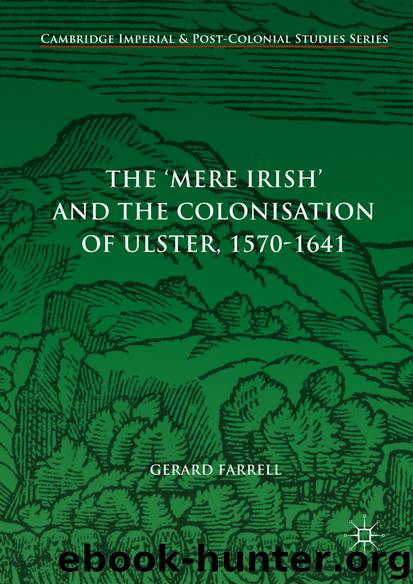The 'Mere Irish' and the Colonisation of Ulster, 1570-1641 by Gerard Farrell

Author:Gerard Farrell
Language: eng
Format: epub
Publisher: Springer International Publishing, Cham
The Class Structure of Gaelic Society
The first thing to be noted about the hierarchy of Gaelic society is that it was intrinsically linked to the rights and obligations associated with the ownership and rental of cattle, and that landholding, and the conceptualisation of land, differed from that in a common law jurisdiction in several important respects. Instead of being associated with a strict hierarchy of divisions and subdivisions as applied to territories with neatly defined boundaries, sovereignty as exercised by the tiarnaí should be understood as largely exercised over specific sliocht and their rights to use cattle. 19 Such boundaries could contract, expand or simply move, especially in times of dislocation; therefore, the fluid nature of landholding in Gaelic society must be appreciated. Having said this, the point should not be overstated; the area which constituted an oireacht might fluctuate over the centuries, but remained stable enough for the northern half of what is today known as County Londonderry , for example, to be referred to as Oireacht Uí Chatháin , after the O’Cahans.
Just as the territory of a tiarna expanded or contracted according to his fortunes in battle and diplomacy, so could the extent of his tiarnas (chieftainship or lordship) in relation to other tiarnaí. O’Cahan is usually given as the prime example of an uirrí or sub-king for his subservient relationship to the O’Neills , but as Nicholls has noted of O’Cahan specifically, relationships as well as territories fluctuated and the control exercised by the O’Neills over O’Cahans was relatively weak compared to that exercised over a less powerful tiarna such as O’Gormley . 20 In general, the reciprocal relationship between a tiarna and his uirrí took the form of tribute and military service, in return for which he received protection from outside threats. In the latter part of the sixteenth century, two overlords—O’Neill and O’Donnell—existed in Ulster, to whom the various uirríthe were attached. It is clear, however, that such a system was breaking down, as the growing disorder left some tiarnaí unable to maintain alliances with their erstwhile uirríthe, whom the government often tried to detach from their allegiance as a means of weakening Gaelic resistance. The ambiguity in Donall O’Cahan’s relationship with his overlord, for example, was exploited by those who wished to undermine the authority of Hugh O’Neill in the immediate post-Mellifont years.
Such was the importance of lineage and hierarchical relationships between different sleachta that the Irish primarily identified themselves with perceived common ancestry rather than particular geographical locations. 21 These perceived origins were articulated in terms of the cineál , meaning branch or race, and which connote a more long-term view of ancestry in the distant, semi-mythical past than the terms sliocht or fine. Most of the prominent sleachta of Ulster in the sixteenth century traced their origins to Niall Naoighiallach (Niall of the Nine Hostages), and were thus known as the Uí Néill, the descendants of Niall . 22 These in turn were split into two main lineages, the Cineál Eoghain and
Download
This site does not store any files on its server. We only index and link to content provided by other sites. Please contact the content providers to delete copyright contents if any and email us, we'll remove relevant links or contents immediately.
| Africa | Americas |
| Arctic & Antarctica | Asia |
| Australia & Oceania | Europe |
| Middle East | Russia |
| United States | World |
| Ancient Civilizations | Military |
| Historical Study & Educational Resources |
Underground: A Human History of the Worlds Beneath Our Feet by Will Hunt(11839)
Sapiens by Yuval Noah Harari(5123)
Navigation and Map Reading by K Andrew(4889)
The Sympathizer by Viet Thanh Nguyen(4095)
Barron's AP Biology by Goldberg M.S. Deborah T(3944)
5 Steps to a 5 AP U.S. History, 2010-2011 Edition (5 Steps to a 5 on the Advanced Placement Examinations Series) by Armstrong Stephen(3638)
Three Women by Lisa Taddeo(3278)
The Comedians: Drunks, Thieves, Scoundrels, and the History of American Comedy by Nesteroff Kliph(2994)
Water by Ian Miller(2953)
Drugs Unlimited by Mike Power(2484)
The House of Government by Slezkine Yuri(2103)
DarkMarket by Misha Glenny(2099)
A Short History of Drunkenness by Forsyth Mark(2067)
And the Band Played On by Randy Shilts(2014)
The Library Book by Susan Orlean(1999)
Revived (Cat Patrick) by Cat Patrick(1896)
The Woman Who Smashed Codes by Jason Fagone(1874)
The House of Rothschild: Money's Prophets, 1798-1848 by Niall Ferguson(1809)
Birth by Tina Cassidy(1803)
